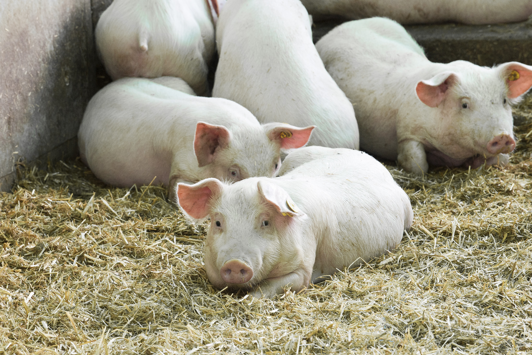This page outlines the requirements for identifying pigs in Western Australia and recording their movement between locations, in accordance with the Biosecurity and Agriculture Management (Identification and Movement of Stock and Apiaries) Regulations 2013.
All livestock owners and non-farming property operators in Western Australia are also required to be registered.
Stock traceability is the first step in good biosecurity and is a key part of everyday sound farm management practices. Traceability is essential to maintain access to export markets and for food safety, and it allows stock to be traced for disease or residue purposes.
Identification requirements
Pigs are required to be identified before being moved from the farming property where they are kept. Identification options include marking a registered identifier (i.e. pig tattoo) applied as a slap brand or NLIS device/tag.
Your registered pig tattoo consists of an arrangement of 5 numerals. It's presented in the following format: 12/123 and is the same number as your registration number.
Your registered pig tattoo can be applied as a slap brand tattoo to identify pigs, but only for pigs that are 25 kg and over.
A slap brand consists of needles inserted into a block and inked with approved carbon black paste or tattooing ink/dye. Slap brands must be ordered through or rural retailer.
If choosing to use the tattoo:
- Before leaving the property of birth, pigs 25 kg and over must have the slap brand applied to the left shoulder with the tattoo registered to that property.
- Before leaving any other property, introduced pigs and those of uncertain origin must have the slap brand applied to the right shoulder with the tattoo registered to that property. If the right shoulder has been previously used for a previous tattoo, then apply to the right rump, then the left rump.
Owners may choose this method of identification, particularly for non-commercial pigs. This is the only method for identifying pigs under 25 kg. NLIS devices/tags must be ordered through an approved manufacturer or rural retailer using your registered owner of livestock PIC information.
Before leaving the property of birth, pigs under 25 kg must be tagged in their left ear with a yellow NLIS breeder tag bearing the PIC of that property.
Before leaving any other property, pigs under 25 kg must be tagged in their right ear with an orange NLIS post-breeder tag bearing the PIC of that property.
Using an NLIS tag with the correct placement and colour as described is an option for pigs 25 kg and over.
When an NLIS tag is applied, it must stay with the pig for life and not be removed. If an NLIS tag is lost, a replacement tag must be applied to the pig with the appropriate tag for its current PIC of residence.
Unweaned pigs can be moved without identification as long as it’s being moved with its correctly identified mother from the property on which it is kept to another property with the same relevant PIC.
In other situations, an application can be made to DPIRD inspector for approval to move pigs without the required NLIS identification for consideration on a case-by-case basis in accordance with the Regulations.
Please note the following:
- You must not take your slap brand or NLIS pig tags off the property (PIC) they are registered to without a permit from the department.
- NLIS tags issued for use on one property cannot be used to identify animals located on another property with a different PIC.
- NLIS pig tags cannot be sold, given away or reused.
- NLIS-accredited tags are ordered through your rural supplier or online directly from the manufacturers. You will need to provide your approved PIC when ordering.
- Once an NLIS tag is attached to a pig, it must not be removed until the animal is processed in an abattoir.
Requirements for moving pigs
Using waybills and PigPass NVDs
Whether you move one pig, 20 pigs or a pet pig off your property, you must have a completed movement document to accompany the pigs and upload movement data into one of two systems, to ensure lifetime traceability is maintained.
This includes movements to other farms or properties where ownership or PIC changes, abattoirs, saleyards or showgrounds (this also applies to shows and events, when pigs are returned to their original property).
Supporting documentation also provides proof that pigs are being moved with the owner's consent and it must remain with the animals as they are being transported.
You can complete movement documentation using a waybill and uploading the movement on the NLIS database. Alternatively, you can accompany movements using a PigPass National Vendor Declaration (NVD). If you use PigPass, your movement data will automatically update the NLIS database.
All movements must be recorded within 48 hours after pigs have been moved and must be completed by the receiver.
All movement records and documents must be kept for a minimum of 7 years.
Registering with PigPass
To register with PigPass, contact 1800 001 458 or via the PigPass website.
Offences and fines
If you're an owner of livestock, you have a responsibility to ensure that you meet the requirements of the Biosecurity and Agriculture Management (Identification and Movement of Stock and Apiaries) Regulations 2013.
The penalty for a breach of this legislation may be a fine of up to $20,000.
Offences under the regulations include:
- Possessing stock that are not legally identified.
- Using another person's registered identifiers brand, earmark or tattoo.
- Possessing another person's registered identification equipment.
- Applying your tattoo or NLIS tags to animals on another person's property.
- Using another person's NLIS tags.
- Removing NLIS ear tags.
- Trading or moving animals without correct identification.
- Failure to correctly transfer ownership of pigs (via either PigPass or NLIS database) after each movement to a different PIC.

